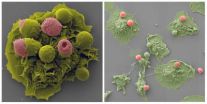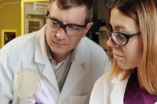(Press-News.org) Chronic obstructive pulmonary disease (COPD) is associated with eosinophilic airway inflammation in 10–20% of patients. Benralizumab, a monoclonal antibody, has been shown to decrease the number of blood and sputum eosinophils. In this trial of 101 patients with COPD whether benralizumab reduces the number of acute exacerbations was investigated. Benralizumab was found to be no more effective at preventing acute COPD exacerbations than placebo overall. However, the authors conclude that subgroup analyses suggest more research into the use of benralizumab in patients with COPD and eosinophilia is required.
INFORMATION: END
The Lancet Respiratory Medicine: Benralizumab for chronic obstructive pulmonary disease and sputum eosinophilia
A randomized, double-blind, placebo-controlled, phase 2a study
2014-09-08
ELSE PRESS RELEASES FROM THIS DATE:
Dynamic duo takes out the cellular trash
2014-09-07
LA JOLLA—In most of the tissues of the body, specialized immune cells are entrusted with the task of engulfing the billions of dead cells that are generated every day. When these garbage disposals don't do their job, dead cells and their waste products rapidly pile up, destroying healthy tissue and leading to autoimmune diseases such as lupus and rheumatoid arthritis.
Now, Salk scientists have discovered how two critical receptors on these garbage-eating cells identify and engulf dead cells in very different environments, as detailed today in Nature Immunology.
"To ...
Platelet-like particles augment natural blood clotting for treating trauma
2014-09-07
A new class of synthetic platelet-like particles could augment natural blood clotting for the emergency treatment of traumatic injuries – and potentially offer doctors a new option for curbing surgical bleeding and addressing certain blood clotting disorders without the need for transfusions of natural platelets.
The clotting particles, which are based on soft and deformable hydrogel materials, are triggered by the same factor that initiates the body's own clotting processes. Testing done in animal models and in a simulated circulatory system suggest that the particles ...
Why age reduces our stem cells' ability to repair muscle
2014-09-07
Ottawa, Canada (September 7, 2014) — As we age, stem cells throughout our bodies gradually lose their capacity to repair damage, even from normal wear and tear. Researchers from the Ottawa Hospital Research Institute and University of Ottawa have discovered the reason why this decline occurs in our skeletal muscle. Their findings were published online today in the influential journal Nature Medicine.
A team led by Dr. Michael Rudnicki, senior scientist at the Ottawa Hospital Research Institute and professor of medicine at the University of Ottawa, found that as muscle ...
Rethinking the basic science of graphene synthesis
2014-09-07
A new route to making graphene has been discovered that could make the 21st century's wonder material easier to ramp up to industrial scale. Graphene -- a tightly bound single layer of carbon atoms with super strength and the ability to conduct heat and electricity better than any other known material -- has potential industrial uses that include flexible electronic displays, high-speed computing, stronger wind-turbine blades, and more-efficient solar cells, to name just a few under development.
In the decade since Nobel laureates Konstantin Novoselov and Andre Geim proved ...
Targeting the protein-making machinery to stop harmful bacteria
2014-09-07
One challenge in killing off harmful bacteria is that many of them develop a resistance to antibiotics. Researchers at the University of Rochester are targeting the formation of the protein-making machinery in those cells as a possible alternate way to stop the bacteria. And Professor of Biology Gloria Culver has, for the first time, isolated the middle-steps in the process that creates that machinery—called the ribosomes.
"No one had a clear understanding of what happened inside an intact bacterial cell," said Culver, "And without that understanding, it would not be ...
Continuing Bragg legacy of structure determination
2014-09-07
Over 100 years since the Nobel Prize-winning father and son team Sir William and Sir Lawrence Bragg pioneered the use of X-rays to determine crystal structure, University of Adelaide researchers have made significant new advances in the field.
Published in the journal Nature Chemistry today, Associate Professors Christian Doonan and Christopher Sumby and their team in the School of Chemistry and Physics, have developed a new material for examining structures using X-rays without first having to crystallise the substance.
"2014 is the International Year of Crystallography, ...
Ultraviolet light-induced mutation drives many skin cancers, Stanford researchers find
2014-09-07
A genetic mutation caused by ultraviolet light is likely the driving force behind millions of human skin cancers, according to researchers at the Stanford University School of Medicine.
The mutation occurs in a gene called KNSTRN, which is involved in helping cells divide their DNA equally during cell division.
Genes that cause cancer when mutated are known as oncogenes. Although KNSTRN hasn't been previously implicated as a cause of human cancers, the research suggests it may be one of the most commonly mutated oncogenes in the world.
"This previously unknown oncogene ...
Ultra-thin, high-speed detector captures unprecedented range of light waves
2014-09-07
New research at the University of Maryland could lead to a generation of light detectors that can see below the surface of bodies, walls, and other objects. Using the special properties of graphene, a two-dimensional form of carbon that is only one atom thick, a prototype detector is able to see an extraordinarily broad band of wavelengths. Included in this range is a band of light wavelengths that have exciting potential applications but are notoriously difficult to detect: terahertz waves, which are invisible to the human eye.
A research paper about the new detector ...
Researchers discover a key to making new muscles
2014-09-07
La Jolla, Calif., September 7, 2014 -- Researchers at Sanford-Burnham Medical Research Institute (Sanford-Burnham) have developed a novel technique to promote tissue repair in damaged muscles. The technique also creates a sustainable pool of muscle stem cells needed to support multiple rounds of muscle repair. The study, published September 7 in Nature Medicine, provides promise for a new therapeutic approach to treating the millions of people suffering from muscle diseases, including those with muscular dystrophies and muscle wasting associated with cancer and aging.
There ...
UK study identifies molecule that induces cancer-killing protein
2014-09-07
LEXINGTON, Ky. (Sept. 8, 2014) – A new study by University of Kentucky researchers has identified a novel molecule named Arylquin 1 as a potent inducer of Par-4 secretion from normal cells. Par-4 is a protein that acts as a tumor suppressor, killing cancer cells while leaving normal cells unharmed.
Normal cells secrete small amounts of Par-4 on their own, but this amount is not enough to kill cancer cells. Notably, if Par-4 secretion is suppressed, this leads to tumor growth.
Published in Nature Chemical Biology, the UK study utilized lab cultures and animal models ...
LAST 30 PRESS RELEASES:
New study sheds light on Milky Way's mysterious chemical history
Could altering the daily timing of immunotherapy improve survival in people with cancer?
Weaving secondary battery electrodes with fibers and tying them like ropes for both durability and performance
Using social media may impair children’s attention
Science briefing: An update on GLP-1 drugs for obesity
Lower doses of immunotherapy for skin cancer give better results
Why didn’t the senior citizen cross the road? Slower crossings may help people with reduced mobility
ASH 2025: Study suggests that a virtual program focusing on diet and exercise can help reduce side effects of lymphoma treatment
A sound defense: Noisy pupae puff away potential predators
Azacitidine–venetoclax combination outperforms standard care in acute myeloid leukemia patients eligible for intensive chemotherapy
Adding epcoritamab to standard second-line therapy improves follicular lymphoma outcomes
New findings support a chemo-free approach for treating Ph+ ALL
Non-covalent btki pirtobrutinib shows promise as frontline therapy for CLL/SLL
University of Cincinnati experts present research at annual hematology event
ASH 2025: Antibody therapy eradicates traces of multiple myeloma in preliminary trial
ASH 2025: AI uncovers how DNA architecture failures trigger blood cancer
ASH 2025: New study shows that patients can safely receive stem cell transplants from mismatched, unrelated donors
Protective regimen allows successful stem cell transplant even without close genetic match between donor and recipient
Continuous and fixed-duration treatments result in similar outcomes for CLL
Measurable residual disease shows strong potential as an early indicator of survival in patients with acute myeloid leukemia
Chemotherapy and radiation are comparable as pre-transplant conditioning for patients with b-acute lymphoblastic leukemia who have no measurable residual disease
Roughly one-third of families with children being treated for leukemia struggle to pay living expenses
Quality improvement project results in increased screening and treatment for iron deficiency in pregnancy
IV iron improves survival, increases hemoglobin in hospitalized patients with iron-deficiency anemia and an acute infection
Black patients with acute myeloid leukemia are younger at diagnosis and experience poorer survival outcomes than White patients
Emergency departments fall short on delivering timely treatment for sickle cell pain
Study shows no clear evidence of harm from hydroxyurea use during pregnancy
Long-term outlook is positive for most after hematopoietic cell transplant for sickle cell disease
Study offers real-world data on commercial implementation of gene therapies for sickle cell disease and beta thalassemia
Early results suggest exa-cel gene therapy works well in children
[Press-News.org] The Lancet Respiratory Medicine: Benralizumab for chronic obstructive pulmonary disease and sputum eosinophiliaA randomized, double-blind, placebo-controlled, phase 2a study




